Greetings, photography friends! Today, we are diving into the digitization of stereo slides that were captured by Dr. Waldo L. Schmitt during the Smithsonian-Bredin Belgian Congo Expedition of 1955. The expedition, part of a series led by Dr. Schmitt, explored multiple sites along the Congo River to document some of the cultures, industries, plants, and animals of Central Africa. Later Smithsonian-led expeditions, similarly underwritten by Mr. and Mrs. Bruce Bredin, travelled to the Caribbean. Dr. Schmitt took copious photographs and notes during his travels, and his collection of papers ultimately came to the Smithsonian Institution Archives, where they are being digitized as part of the Field Book Project. Dr. Schmitt’s slides present unique challenges for photography because they have both reflective and transmissive elements and require careful lighting to properly capture. His stereo slides are no exception.
So, what are "stereo slides"? Think View-Master.
When two offset images are placed in front of both eyes, the brain stitches together a compound image with an illusory dimension of depth. That false depth provides a 3-D look. View-Masters work along the same principle, with pairs of images set in a rotating disk.

In the 1950s, Kodak came out with a Stereo Camera that could capture these kinds of pictures in the field. Dr. Schmitt probably had a similar model during the Smithsonian-Bredin Belgian Congo Expedition in 1955. Once the film was developed, the images were placed into stereo slide mounts (either metal or paper) for easy viewing.
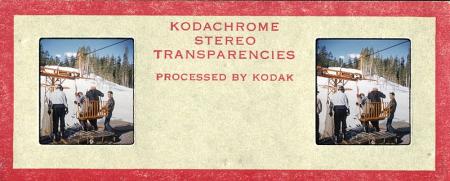
The stereo slides from this particular expedition are almost all in metal mounts with surprisingly sharp edges. The slide has both reflective (the metal) and transmissive (the images) elements, which requires a dual lighting setup to image it. They are also fairly small, adding focal distance and depth-of-field challenges. Here are four tips we discovered during photography of these slides.
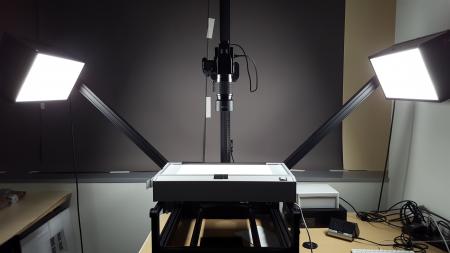
- Use a standard slide setup - Our standard slide setup includes both copy lights and a light table. That way, we can capture both the transmissive and reflective light in one take.
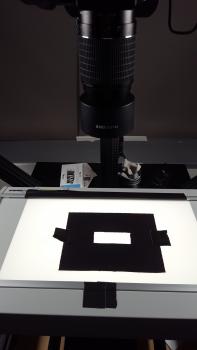
- Make a paper mount - The light table has soft plastic that is prone to scratches when in contact with metal. We cut black paper to fit just barely under the slide to protect the plastic from the metal. This also makes the background black, which is easier on the eyes than the white of the light table, and allows you to place the slide in the same spot every time.
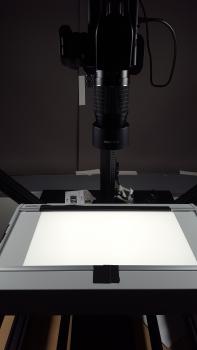
- Set white balance to favor transmissive over reflective light - The warm copy lights have a slightly different color temperature than the cool light table. It was hard to balance both without making either one too warm or cool. In the end, we favored the light table over the copy stand. That meant the transmissive light of the tiny photos within the slides is slightly truer than the reflected light on the metal.
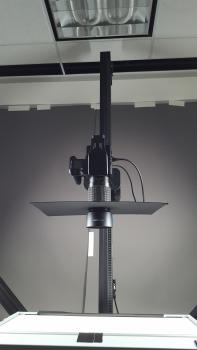
- Add a black cover around the lens to prevent unwanted light reflecting from the ceiling – The Archives’ photography lab has fluorescent lights in the ceiling that are lined with metal for diffusion. That metal reflects light, and if the slides have metal as well, then they reflect unwanted light a second time, distorting photography. To solve this, we put a black cover around the lens to stop light from bouncing up to the ceiling.
Here is an example of the finished product. Several boxes of these are coming through the pipeline, so check back soon for new items!
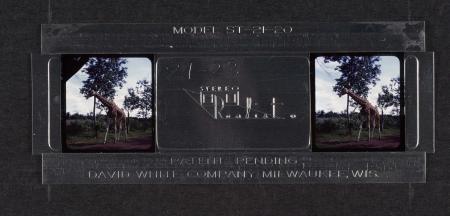
Have you been charged with photographing old media from the moderately distant past? Historic houses? Microfiche? Metal coins? Share your tips and tricks in the comments below.
Related Resources
- Stereo slides: Smithsonian-Bredin Belgian Congo Expedition, 1955, Smithsonian Institution Archives
- On Expedition with Waldo Schmitt, Smithsonian Institution Archives
- Field Books of Waldo Schmitt, Smithsonian Institution Archives
- Stereoscopy, Wikipedia
- Kodak Stereo Camera, Wikipedia
Produced by the Smithsonian Institution Archives. For copyright questions, please see the Terms of Use.

Leave a Comment